TWO ON AND WITH
4 May 2024By Fan Wu & Jeremy Laing

Jeremy Laing appears in blue, Fan Wu speaks in violet.
MIRROR-VASE DOT JAY PEE GEE
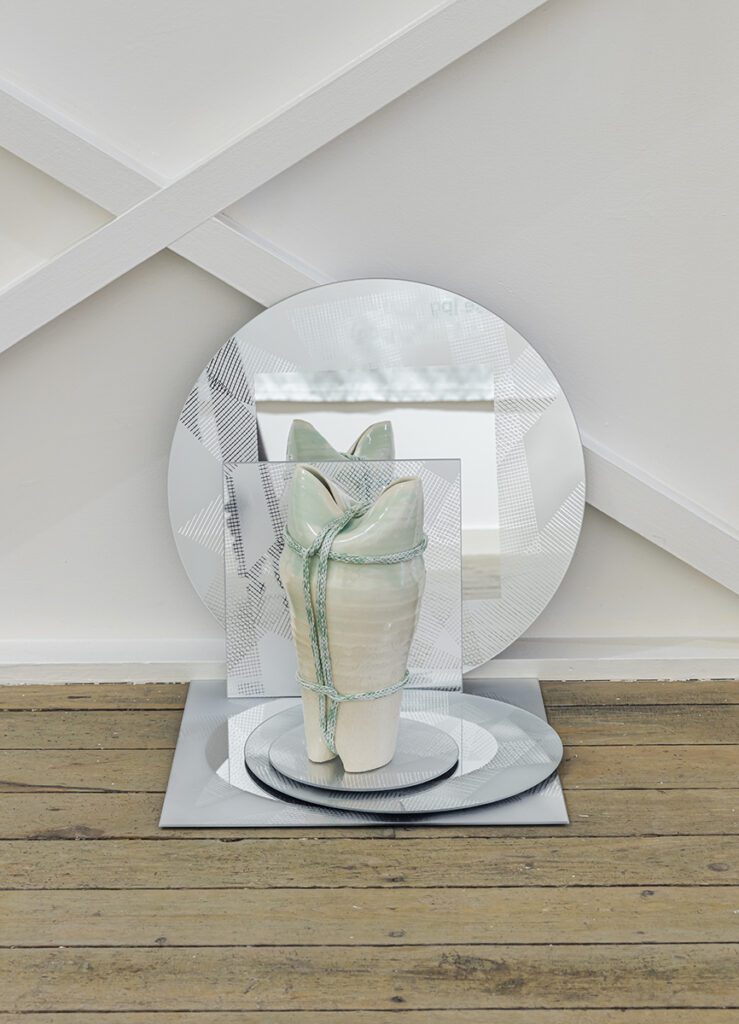
It’s giving Shibari Klein bottle. Immanence is the simultaneity of self-enclosure and self-disclosure. Whoever invented the mirror is evil, they say, for it gives back anxiety in the form of one’s own supposed “face” (a reverse translation at best). I wonder if I bring too many toys into the bedroom and so betray a love for gadgetry that reminds him—or worse, reminds me—unerotically of my father. M.C. Richards: “One may think of metamorphosis as the principle by which creative energy is saved from being bound in static forms.”1
Richards’ 1964 book Centering in Pottery, Poetry and the Person is a consistent touchstone for me, not a model exactly, but a meditation on non-dualism.
Lightswitch panels, stairways, floorboards: Laing now calls this whole swarm of marginal objets the subcollection. Just to name these things is to do the violence of bringing them up to consciousness, where daylight gifts to everything it touches the glow of the known.
I think I would locate the violence in the suppression from consciousness, but perhaps it floats somewhere in the middle and is the pivot on which bringing up/pressing down hinges. Is violence the act of condensing the realm of possibility into the finest of lines between two options set in opposition?
There is no principle external to transformation, which always allows us respite from paralysis, so long as we think to summon the non-negotiable fact of transformation back to us. One object is called, in fact, a “foiled cake plate;” therefore say no more. I’m seeking an ethics for transformation, a way to build it into my everyday life, a hangnail snagged on the potter’s wheel. To either play with language or fall silent.
To quote from Mirror-vase.jpg, the 16KB image, screen-grabbed from Wikimedia Commons, which is the basis for the show’s mistranslated tapestries, and its name: “No higher resolution available.” A self-contained/proclaimed limit.

I bind my lover in silks and steel wool; we enact the theatre of those submissive sensual games. I fixate on the word selvage: the sense of a final action that gifts the edge with a guarantee of closure.
The final action, but also the originating one—as M.C. Richards might say: “both… and”—the selvage exists on both edges, back-forth, push indeterminable from pull. But is it a gift, to be held so tightly at the edges that you can’t shift and slip a little? Maybe under certain consensual conditions. Borders are generative—to enclose is, in a way, to open up—but are they soft and generous, like a satin-edged blanket? This is pottery language: compressing, opening up.
This is personal language.
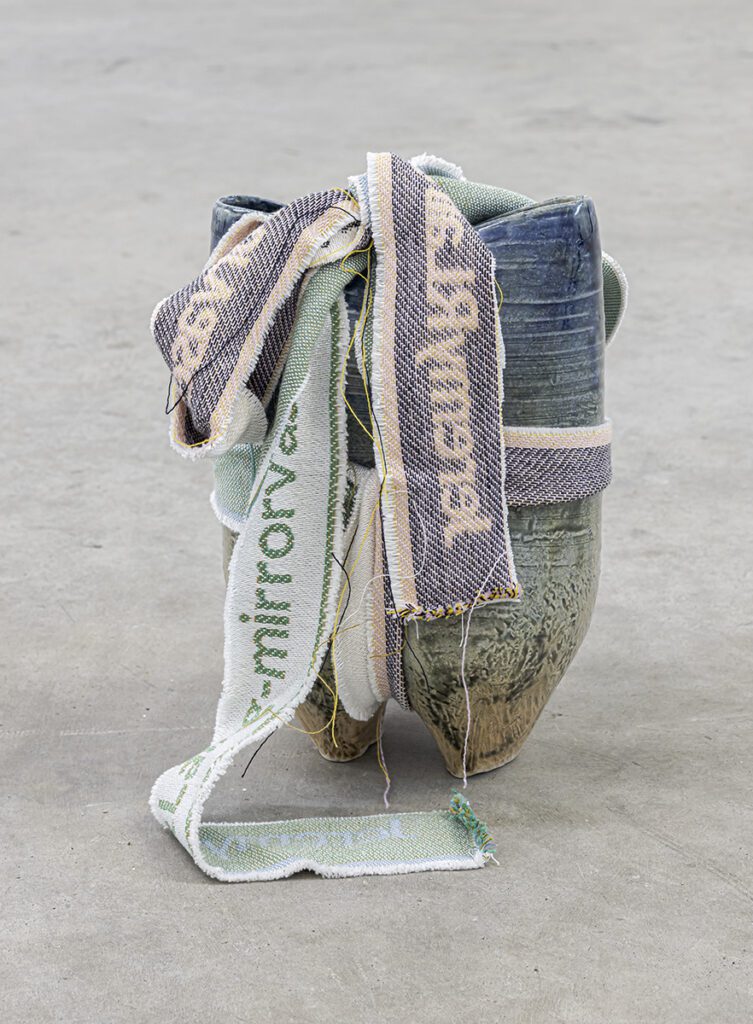
All material toggles (in the language of textiles… it shuttles) into the metaphorical, which is no less material even when invisible. No externalities necessary, like the envelope that licks its own seal (a self-affixing stamp, postage played). Check the etymology: the difference between concatenation (Dave the Potter) and entanglement (Alva Noë) is that the former evokes a linked chain while the latter evokes embarrassment. I have been ashamed, even in the heart of the crowd of the people I love, my face a scrawl or smear I catch from the corner of my eye, ascending the pinkly lit stairs to the club, morning bringing dawn upon the partygoers, the towering remnants of my high resolutely staying past primetime.

The embarrassment of entanglement in the presence of friends—I know what you mean—my words, tentative, here plied with yours, which I always read as quite assured. But I guess we’re both a bit tender in unfamiliar light; new subjects, new forms. And we each have our way with materials, different as they may be, if my pots and your poems—metaphors, containers both—are all that different. Structured voids, the contents—and discontents—of which are the making of themselves.
If you feel clumsy, a subterranean newt blindly crawling out of the rave cave, I feel unformed, like asparagus that has never seen the sun, blanched of its colour, which doesn’t properly belong but emerges conditionally, brought up to the surface by scorching rays, or smothered in cellular depths by a mound of dirt. A cairn for the hues that never were. A matter of translation: if I had been “born a girl” I would “be” Jessamin Roberta Laing, not Jeremy Ryan. We share hankies though—our petit-point monograms are one and the same.
As a child I liked tying things up so much that my parents eventually hid the rope, yarn, and string. Captivated by the tangle of how things come together, I tethered chairs to tables, leg to leg, and joined doorknobs across the hall’s emptiness. A common sight was every last stuffed animal bound up in communion. Concomitantly, I became very good at disentangling—a knot has never bested me. No selvage at the edges, no external order, a knot is self-contained and containing. Following its path is the key to its undoing.
Queerness is not an identity, but another way to name global solidarity for the oppressed, or else it is nothing at all.
It is no thing at all, not solidly, but the dynamic and contingent space between normative affects, orientations, and acts. Not to claim it as a negative space, and get too close to Leo Bersani, but as a conditional, relational one. Perhaps, in that sense, like all spaces. Being attuned to this space is to register the structural inequities and hierarchies that shape it, the not-enoughness-of-the-present-not-just-for-oneself. It’s to imagine and insist on new structures; to denaturalize what has been built to seem inevitable; to at least scratch some of the carefully maintained gilding off of the seemingly pre-ordained frame.
Brook Ziporyn, on Tiantai Buddhism: “Instead of trying to get away from our conditionality and fragile finiteness and its concomitant neuroses, we might say, we are instructed to dwell in them, in fact to become them… To dwell in [our conditionality and finiteness and neuroses] is to be free of them, and fully realized dwelling in them is full freedom from them.”2
To dwell in something is to change it while being shaped by it, affected and affecting.

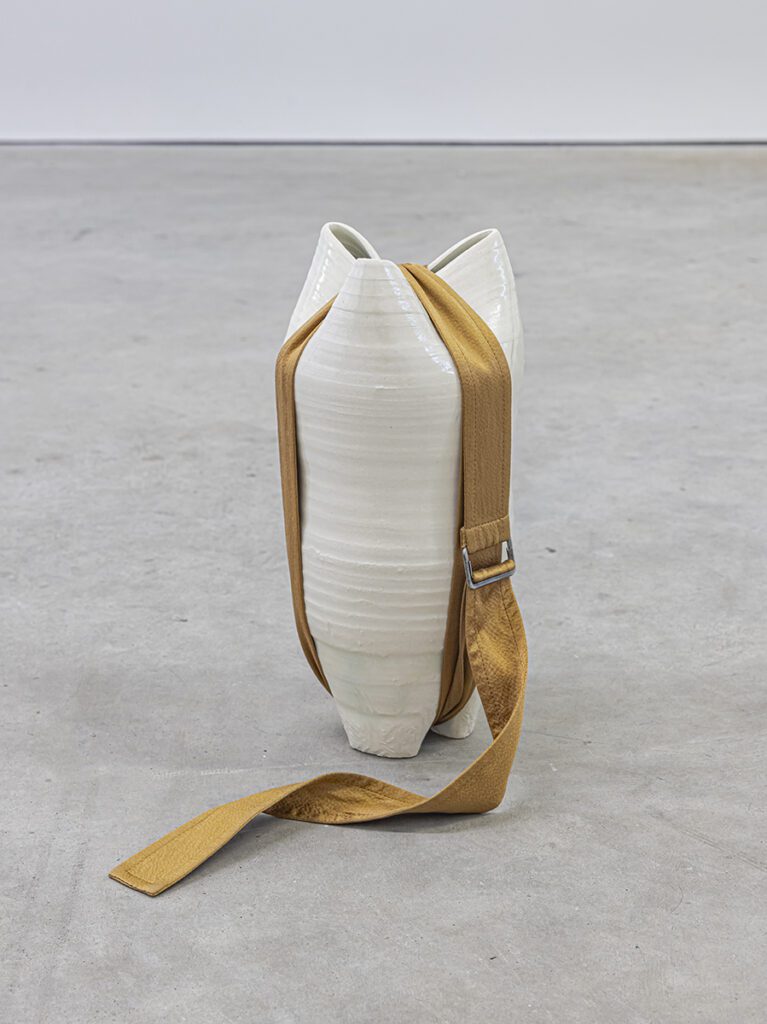

Images: (from left to right) Good/Bad Boy/Girl (For the Lovers), 2020-2023; Contained (container), 2020-2023; Conforming to the shape of the name, 2020-2023 all by Jeremy Laing. Photos by Toni Hafkenscheid courtesy of Susan Hobbs.
What’s so great about The Great Canadian Pottery Throw Down? There’s a w/hole in the middle (“a whole in every part,” M.C. Richards) in which the shape of absolute commitment fits (and absolute detachment, that recursive push-pull). Another Tower of Babel falls to ruin, a perfected form unhinged on the potter’s wheel. First as tragedy, then in teal, finally faded to amber.
“Then in teal” has me back at the Colour Me Beautiful parties my parents hosted in the ‘90s, where everyone would take turns being draped and scrutinized in carrés of various hues, to find, communally, through a sense-consensus, what season one is. Relation, metaphor, identity; I am told you are a Spring. No teal for me; too Winter! Nor amber; too Fall! But turquoise and soft pêche will do me well, million-dollar colour well, my best self figured in the light of others’ eyes. I am also told, both indirectly and point blank, violently raised to consciousness in order that it be violently suppressed—spit on a face to drown a soul—what else I am.
“A mirror reflecting the image of a vase.”
ROUND THE STOCKROOM


Images: Installation views of STOCKROOM, 2024 by Jeremy Laing. Photos by Roya DelSol courtesy of the Art Gallery of Burlington.
I teleported to Burlington on the GO Train. (A matter of orientation.) I haven’t been sleeping much; my body’s been “disregarded but not discarded”;3 my acupuncturist told me I’ve been compensating for my depletedness by riling up an energy I don’t have. When I show up to STOCKROOM I’m prepped for delirium; my internal world of stroke objects is reproduced by the shnazzle inside the curtains, clearly visible only through holes cut in fabric (“show hole” therefore). I walk three hundred circles clockwise outside of the curtain’s perimeter (a matter of orientation); next to me an elderly couple talks of dementia and virtual reality. Dilation between clarity and noise: to see more, objects must fuzz out, wiped off against the screen of those curtains. (A matter of orientation.) Now look up: the ceiling’s first layer is exposed so vents show; the second layer is mirror; the third, nondescript office tile.

I think of the layered realities in Dante’s “Inferno:” first the churn of raw machinery—pastemakers and octodrills?—then the hell of your own blank reflection spat back at you; then finally the blank limbo that overlaps museum with white-collar office. Oh how the sacred drains out! Add to the subcollection ceiling tiles and other manners of the unseen-unmentioned upon which conditions depend. They put shower caps on ring lights (they put shower caps on ring lights!) They did surgery on a grape. A vase has a panoply of foam earplugs stuck to it at odd angles where you imagine holes are not. Movement takes place from meme to meme, and we tell time now as a series of intervals between sculpted images of social media–ready witticisms. (A matter of orientation.) Can a plug plug up what has no opening? Neon plastic belts describe a menagerie, Medusa with her hair down or Cher and Tina performing “Shame Shame Shame.”


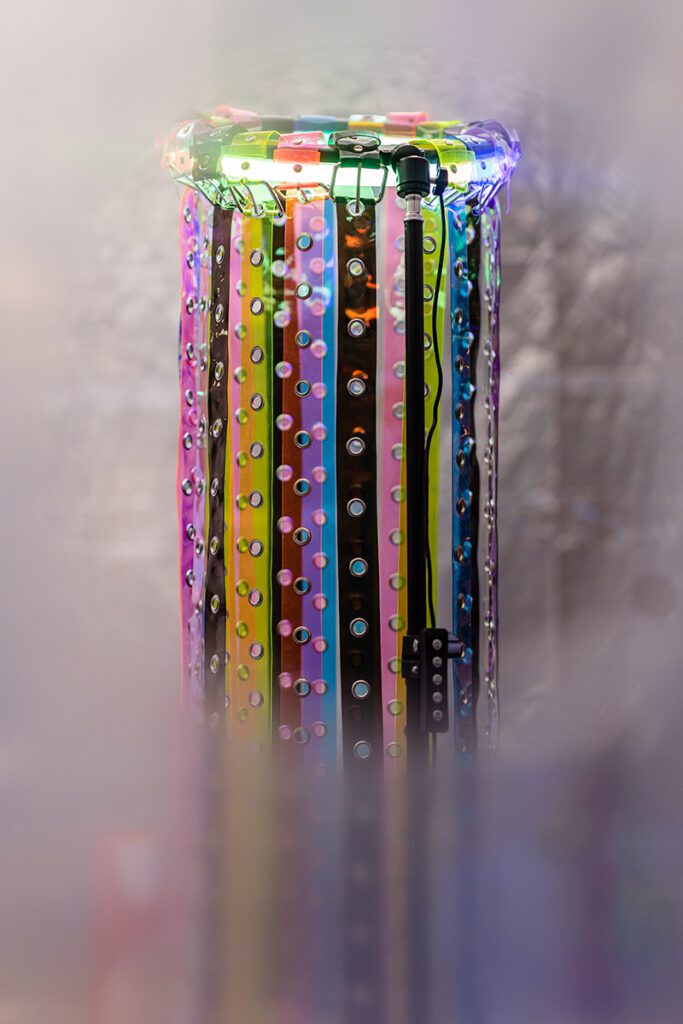
Images: (from left to right) Detail views of STOCKROOM by Jeremy Laing. Photo by Kirk Lisaj courtesy of the artist; Photo by Roya DelSol courtesy of the Art Gallery of Burlington; Photo by Kirk Lisaj courtesy of the artist.
In the drive for totality, the devil is in the proliferation of details. I become obsessed with wanting to see everything, to make sure I capture every facet inside my recording mind before I leave the gallery. But no single view captures the whole space; your perspective obscured by curtain is no less a picture of reality than the hole peered through; each angle on the same object discloses the difference within the same. (A matter of orientation.) In Borges’s short story “Funes the Memorious,”4 a man loses the ability to forget, and so loses the ability to be in language: Because the vase seen at 2:33pm is not the same as the vase seen at 2:34pm from a slightly different angle, so how do we dare call them the same thing? (Matter or orientation.) Stripped of the indignity of names and categories, Funes’s life becomes a psychotic agglutination of unforgettable, unspeakable sensation. This is what STOCKROOM dredged from the Art Gallery of Burlington’s storage lockers and the back roads of my mind.
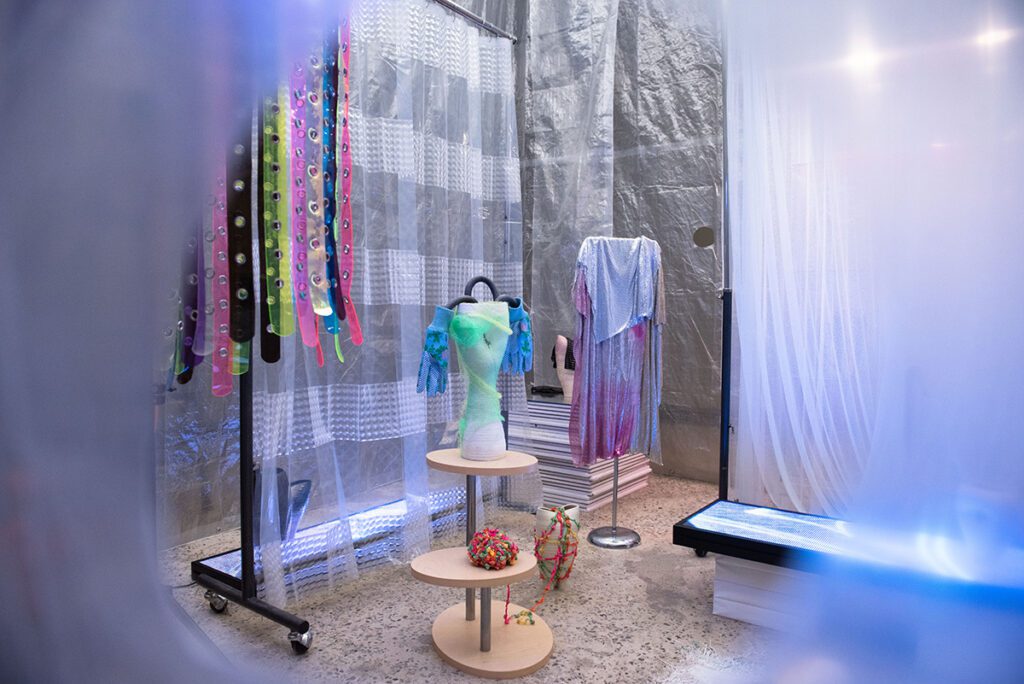
(A matter of orientation.) On the train back to Toronto, hungry, I buy a pack of BLACKPINK-branded strawberry-grape Oreos, a bag of Sweet & Tangy Doritos, and a blackberry (mûre) Perrier. I’m thinking about Jeremy’s question: Is violence the act of condensing the realm of possibility into the finest of lines between two options set in opposition? Counter to this is Brook Ziporyn’s description of Tiantai Buddhism’s conceptual practice of the whole: “The real solution is not to try to escape conditionality to reach some other definite condition of ‘unconditionality’ (which would actually still be conditional), but rather to learn to experience the conditionality in the unconditional and the unconditional in the conditions, the twoness in the oneness and the oneness in the twoness.”5 (A matter of orientation?) (State) violence sets binary logic into stone, offering distinction and opposition as the final answer and truth. We are called to be less settled, indeed forever unsettled, completing the omni-ontological loop that always joins whole to part, from two to one, from stockroom to showroom. (A matter of reorientation.)

- M.C. Richards, Centering in Pottery, Poetry, and the Person, (Middletown: Wesleyan University Press, 1989), 36.
- Brook Ziporyn, Emptiness and Omnipresence, (Bloomington: Indiana University Press, 2016), 205.
- STOCKROOM exhibition text written by Art Gallery of Burlington curator Suzanne Carte, 2024.
- Jorge Luis Borges, Labyrinths, (New York: New Directions, 1964).
- Ziporyn, Emptiness and Omnipresence, (Bloomington: Indiana University Press, 2016), 204.
The solo exhibitions by Jeremy Laing, Mirror-vase.jpg ran from September 9 – October 14, 2023 at Susan Hobbs in Toronto, ON; and STOCKROOM ran from January 19 – April 7, 2024 at the Art Gallery of Burlington.
Feature Image: Installation view of Mirror-vage.jpg by Jeremy Laing. Photo by Toni Hafkenscheid courtesy of Susan Hobbs.



